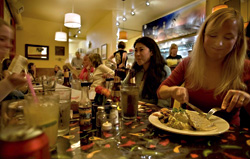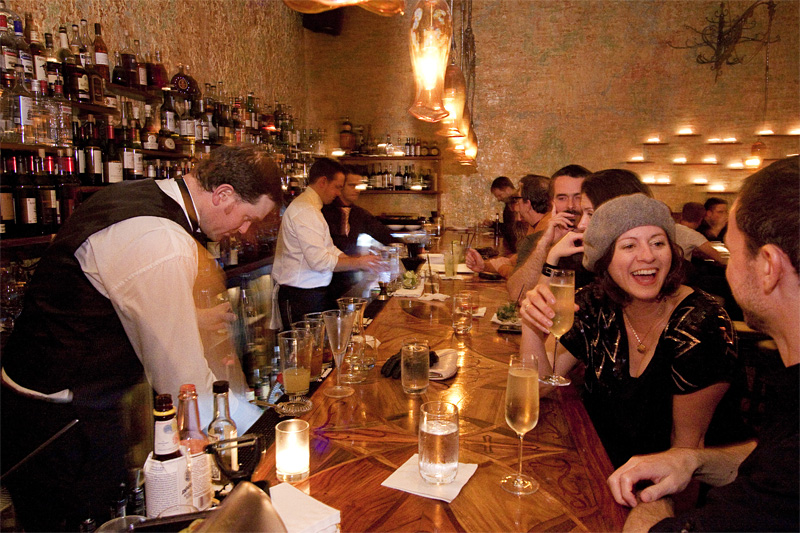“Hey, that’s Explosions in the Sky,” Heather exclaimed, lifting up a finger as if to point to the sound waves ricocheting around her. The band before that: Spoon. Two former Austinites had come with me to authenticity-check Austin Cantina, a sample-sized restaurant on 24th Avenue in Ballard. Shiner Bock on the beer list and the soundtrack of Austin bands were both good signs.
Yet despite the all-things-Texas menu, the lone star in the logo, and the painting of guitar-playing skeletons on its bright yellow walls, the owners’ mission statement perhaps says more about where they’re coming from: “This business is intended to have a profound and positive impact on its community through providing jobs, purchasing local goods, and providing healthful sustenance,” the online pledge states. Grass-fed beef, vegan-friendly menu items, very little lard, and post-irony earnestness—yup, they know they’re in Seattle.
The restaurant glows with a casual, drop-by-anytime warmth. There’s only a small divide between the kitchen and the dining room, and it’s by design. Chef Jefe Birkner, who owns Austin Cantina with his wife, Jennifer, makes sure to say hello to everyone who sits down, and the server approaches the table with the zeal of a believer in Southern hospitality. The Birkners are making one right business decision after another: right pricing, right ingredients, right vibe, right neighborhood. Now they have to polish up the food.
On one visit I heard Jefe, the chef, tell a customer, “Well, I grew up in Chicago, so I’m a Texan by choice.” And like any expat, he’s trying to encapsulate many different culinary styles: Tex-Mex, Hill Country homestyle, and Southwestern bistro. The three cuisines come together in dishes like quesadillas with pulled pork and apple chutney, and chicken-fried steak with chipotle mashed potatoes.
Almost all the bad dishes in my two meals at Austin Cantina fell into one category: Tex-Mex. Jefe fills his tacos and enchiladas with a vegan squash-pepper stew or a choice of three meats. There was a beer-braised “Texas pot roast” and a molasses-tinged pork shoulder (both equally wonderful), as well as a shredded chicken mole (which was so free of mole sauce that it deserves a name change). But the problem wasn’t the pastured, local meat. For the enchiladas, the chef dips corn tortillas in a few tablespoons of a red chili sauce and rolls them around a big scoop of filling before showering the fat rolls with cheese and setting them under the broiler. Without extra sauce—or real, porky lard, as my Austinite friends noted—the enchiladas came out dry where they should have been swimming in sauce and flavor. A dollop of acidic, off-balance guacamole on the side didn’t help.
I’d recommend the tacos—which simply present the meats or vegetable stew with beans, rice, and hot, fresh tortillas for rolling—except the sides were no better. Jefe doesn’t use enough stock to cook his rice, so as it sits warming in the chafing dish, it dries out and gets crunchy. One night’s black beans were a half-hour shy of tender and another night’s “borracho beans,” cooked with beer and veggies, had never been tasted by the cook. How did I know? Not a pinch of salt in them. Insufficient salt also marred what was otherwise the most successful of Jefe’s Tex-Mex dishes: the chili con carne—a bowl of brick-red ground beef with maybe three alarms’ worth of heat, chopped onions, and cheese on top.
Funnily enough, the “interior Mexican” (as the Texans say) dishes came out great. Two empanadas de plantain—deep-fried turnovers made of mashed plantains with oozy mozzarella centers—came with a piquant, oniony, and faintly sweet-tart apple chutney that made the dish. And his camarones mojo de ajo—a dish that normally translates as “overcooked prawns overwhelmed by garlic”—clearly benefited from a chef with some French training. The juicy shrimp popped like ripe grapes in the mouth, and the garlic-chipotle sauce was perfectly made.
The down-home entrées, all of which are priced below most downtown lunch menus, were probably the most enjoyable of all. Calamari rings and tentacles, lightly dredged in chili powder and flour, were pulled out of the fryer at the perfect melting point, and served with a chipotle mayonnaise. The same tangy-hot sauce was squiggled across a chicken breast lacquered in a chipotle-heated barbecue sauce. (It would be nice to see Jefe get over his mid-1990s chipotle obsession; the smoked, dried jalapeños appear in more than a third of the menu items, including a chipotle-chocolate torte.) A bowl of banana slices and Nilla Wafers layered with vanilla pudding came with a browned meringue Smurf-cap on top, an unexpected flair for the ultimate mom dessert.
And then there’s the chicken-fried steak. Yes, it’s accompanied by chipotle (again) mashed potatoes; and there’s a puddle, not a lake, of cream gravy spooned over the top. But the steak is fried to an even gold, and the oil-less breading softly crackles as your fork slides through the steak. I e-mailed Robb Walsh, restaurant critic at the Houston Press and author of The Tex-Mex Cookbook, who recently wrote a feature about chicken-fried steaks across Texas, to find out whether the meat was supposed to be that easy to cut. He sent back a quote from his article. Walsh had asked the same question of chicken-fried-steak expert Dan Jenkins, who’d answered, “It has to have the living shit tenderized out of it.” Authentic enough for me.






